The Ultimate Guide to Instagram For Business (2024)
More and more businesses are leveraging Instagram to generate new customers, increase brand awareness, and promote new products and services.
In fact, a study conducted by Statista showed that Instagram is now among the top three most popular social media marketing channels. The study also revealed that Instagram experienced tremendous compounding growth over the past four years.
So, should your business adopt an Instagram strategy? And if so, how do you create a great Instagram marketing strategy?
Below is a complete guide to leveraging Instagram for business, and it will answer all these questions and more!
How Do I Know if Instagram Is Right for My Business?
Instagram is quickly becoming one of the most profitable social media marketing channels. Here are just a few statistics from Meta that prove its business value:
- 83% of Instagram users discover new products and services on Instagram.
- 81% of Instagram users have used the platform to research products and services.
- 80% of Instagram users have decided whether or not to make a purchase based on Instagram content.
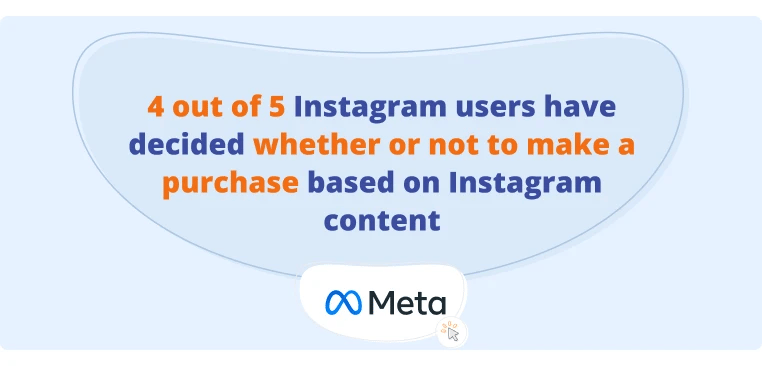
So, how do you know if Instagram is right for your business?
In general, Instagram is an excellent platform for your business if:
- You sell D2C products – it’s super easy to run Instagram ads and allow customers to purchase your product directly inside the Instagram app with Checkout.
- You frequently run B2C or D2C influencer marketing campaigns, as most influencers are active on Instagram.
- Your competitors are already using the platform. If your competitors are using the platform, it’s probably working.
- You’re already investing heavily in visual content marketing (images, videos, etc.).
- You’re building a personal brand and want to develop deeper, more authentic relationships with your audience.
While the scenarios above are excellent signals that Instagram is a promising platform for your business, you’ll see in the examples below that plenty of other businesses don’t fit the categories above and still have great success with Instagram.
For example, many B2B companies realize that Instagram is much less competitive than other platforms, like LinkedIn, so they’ve made it work.
The Benefits of Using Instagram for Business
If you’re still on the fence about using Instagram for your business, here are a few key benefits that might persuade you that Instagram is an excellent social media marketing platform.
1. Affordable Content Creation
Unlike creating a YouTube video or a long-form blog post, it’s fairly easy to quickly create and post high-quality Instagram content.
For example, you can go onto Canva, search for Instagram templates, and customize one in just a few minutes.
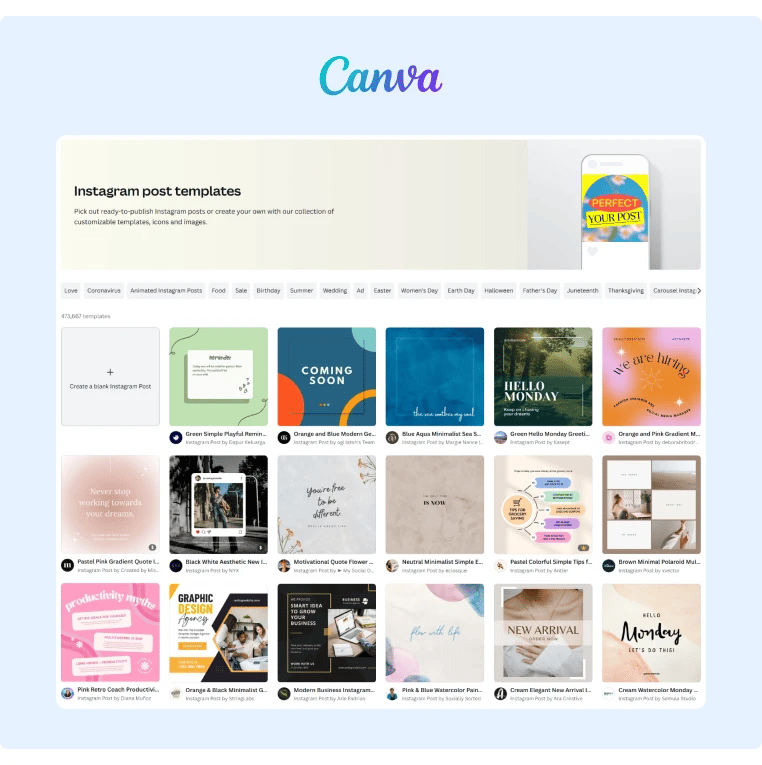
To make the content creation process even faster, you can take a thought leadership post that an executive posted on another platform like LinkedIn or Twitter and then repurpose it on Instagram.
This makes it easy to quickly create a high volume of quality content for relatively cheap.
While you can get more advanced and create professional videos and hire designers to create detailed graphics, plenty of companies succeed on Instagram with simple Canva-style creatives.
2. Advanced Targeting Options and Detailed Tracking
If you’re already running Facebook ads, you’ll be able to easily set up and manage Instagram ads as it uses the same Ads Manager platform.
This also means you’ll have access to Meta’s advanced targeting options. You’ll be able to specify who you want to target by demographic (age, gender, geography, etc.) and interest (as determined by Meta’s data).
You can also set up remarketing ads, specify campaign objectives (traffic, conversions, engagement, etc.), choose your ad placements, and more.
These targeting options are far superior to those offered by other platforms like Twitter or TikTok, which means you’ll likely see a better ROI.
Instagram also offers a detailed analytics tool (Instagram Insights) that makes it easy to see which campaigns are most effective.
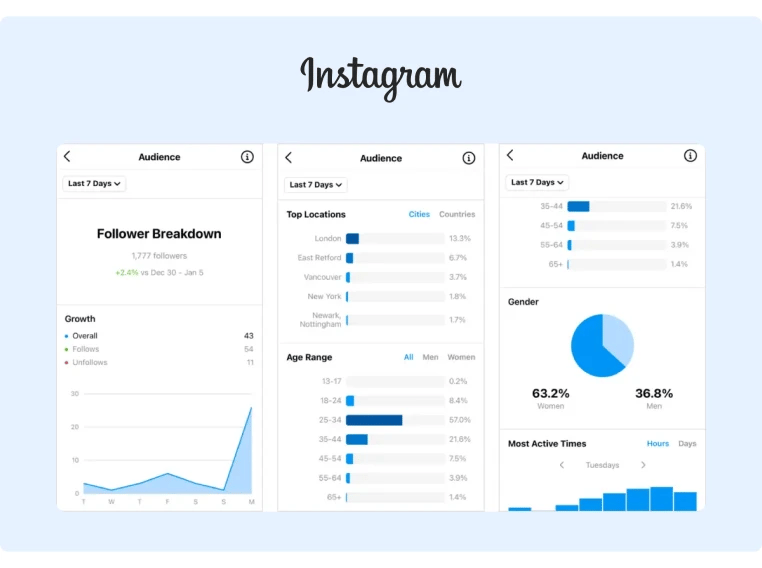
To get started, create an Instagram Business account, which will walk you through setting up your first ad. You can learn more about setting up Instagram ads in this guide.
3. Optimized for Conversions
Another reason Instagram ads are highly effective is that the Checkout feature allows customers to purchase products directly inside the app.
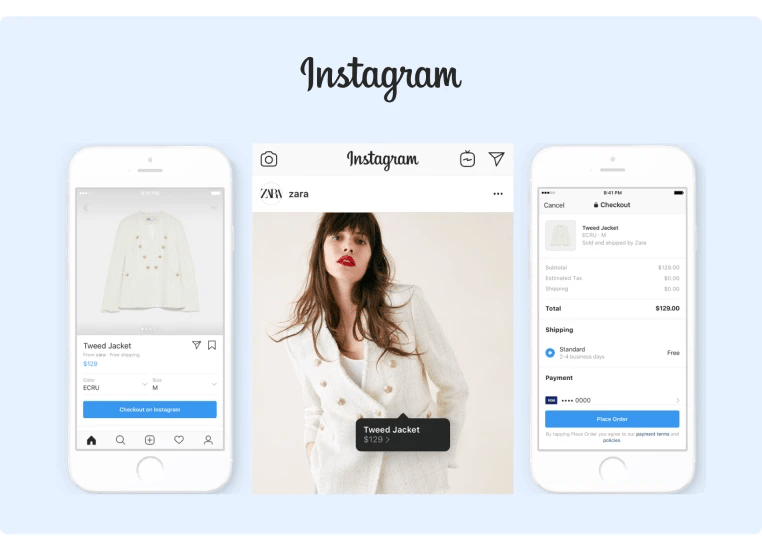
The Checkout feature can help you increase impulse buys and boost conversion rates by making the shopping process seamless.
In fact, a study by Baymard found that 17% of shoppers leave if the checkout process is too long or complicated.
So, by leveraging Instagram’s Checkout feature, customers never even have to visit your website to purchase your product.
4. Less Competition
While many e-commerce brands use Instagram for advertising, it is still a relatively untapped marketing channel for B2B brands.
However, a few B2B brands and influencers have proven that Instagram is also an excellent channel for a more professional audience.
Chris Do is a perfect example.
He has amassed an impressive audience of over 800,000 B2B followers, which has helped him achieve 300% year over year growth for his second seven-figure business.
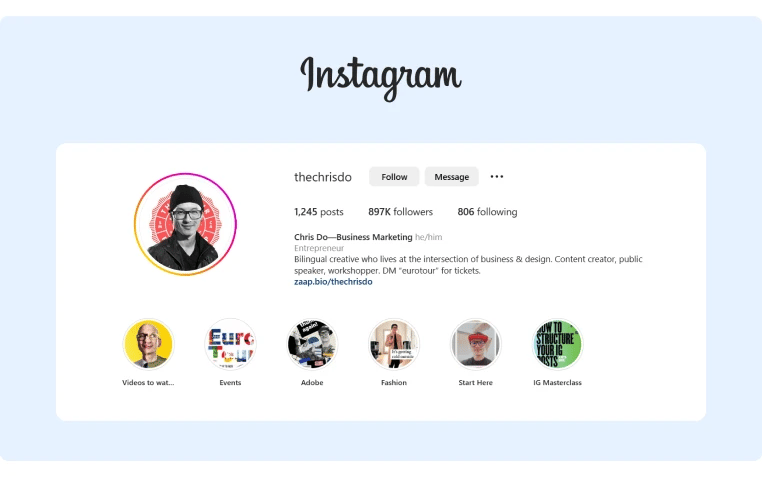
So, while most B2B brands and influencers are fighting for attention on LinkedIn and Twitter, Instagram is significantly less crowded and can help you quickly generate a lot of brand awareness.
5. Plenty of Influencer Partnership Opportunities
Another reason Instagram is an excellent platform for businesses (particularly B2C and D2C businesses) is that there are plenty of influencer marketing opportunities.
In fact, if you use an influencer marketing platform like Upfluence, you’ll find that most influencers available for partnership collaborations are primarily active on Instagram.
While you can run influencer marketing campaigns without a highly active Instagram business profile, they probably won't be as effective, as potential customers who view the influencer's content will learn more by checking your Instagram business profile. So, if there's very little activity on your Instagram profile, that's not a great sign to potential customers.
How To Use Instagram for Business Promotion
Below we'll lay out a detailed Instagram marketing strategy with best practices and pro tips to help you build a high-quality audience.
Step 1. Consistently Create Quality Content
Creating quality content may seem like an obvious key to success, but poor or inconsistent content is the most common reason companies fail on Instagram.
Fortunately, you don't have to spend a fortune on design or production to create high-quality Instagram content. Instead, focus on improving the content ideas. Here are some examples for both e-commerce and B2B brands.
Content Ideas For B2B Brands:
- Case study style content ("How we achieved X").
- Business hero quotes.
- Repurpose thought leadership content (executive interview clip, LinkedIn thought leadership post, etc.).
- Step-by-step "how to" content.
- Behind-the-scenes content.
- Team and company culture content.
Content Ideas for E-commerce Brands:
- Run a giveaway contest.
- User-generated content.
- Memes.
- Behind-the-scenes content.
- "How to" hacks.
- Team members doing popular challenges (e.g., Ice Bucket Challenge).
Now that you have a few content ideas, here's a breakdown of all the different types of content you can create for Instagram.
Standard Photo/Video Posts
Standard video and photo posts are the most traditional style of Instagram content. You can upload a photo or video, edit it with some of Instagram's editing tools and effects, and then add a few relevant hashtags.
Here's an example of a standard Instagram photo post:
Here’s an example of a standard Instagram video post:
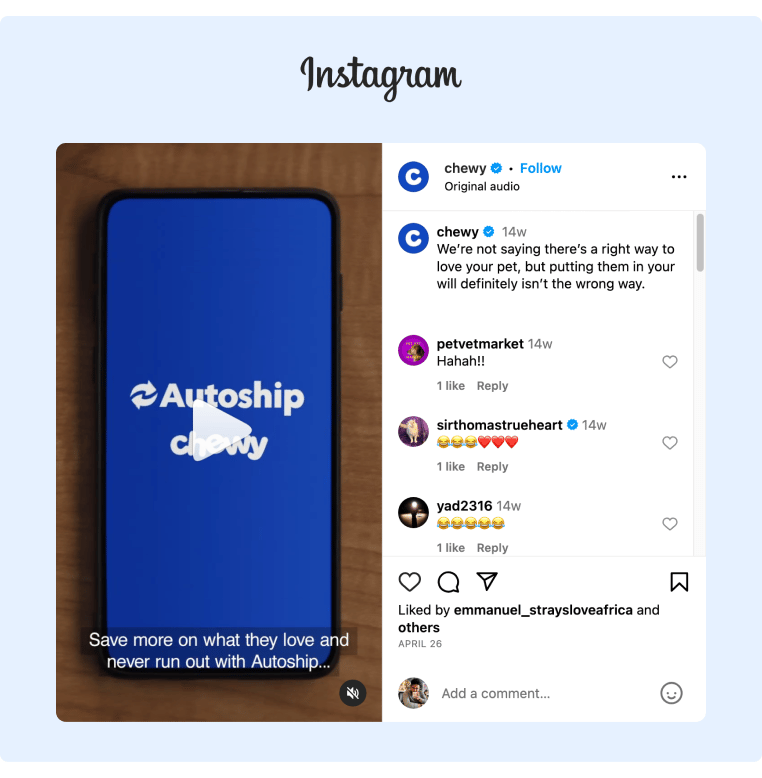
Standard Instagram Post Optimization Tips:
- Start with an interesting content idea. You can use one of the ones we mentioned above.
- Use hashtags.
- Add captions to videos.
- Leverage Instagram's effect and editing features.
- Tag other relevant users.
Instagram Reels
Instagram Reels are 90-second videos similar to TikTok content and YouTube shorts. To create an Instagram Reel, you can use one of Instagram's templates and edit it with Instagram's tools (cropping, effects, music, etc.).
Here's an excellent example of an Instagram Reel from Patagonia that showcases one of its customers:
Instagram Reel Optimization Tips:
- Include on-text closed captions.
- If you repurpose content from TikTok, remove the watermark.
- Leverage three to five relevant hashtags.
- Optimize the video for Instagram’s dimensions (size should be an aspect ratio of 9:16, dimensions of 1080 pixels x 1920 pixels, and 90 seconds in length).
- Take advantage of editing tools (music, cuts, etc.).
Instagram Live
While IGTV no longer exists, you can still run Instagram lives. This content format is an excellent way to interact directly with your customers. You can also save Instagram lives as videos to repurpose later, and you can simultaneously stream on Instagram and Facebook to maximize reach.
Here's a great example of a casual live stream that B2B influencer Vanessa Lau ran to answer common audience questions and engage with them in real-time:
Instagram Live Optimization Tips:
- Plan your live stream at a time that's convenient for your target audience. (This is particularly important if you have a global audience.)
- Promote your live stream in advance so that people know when to show up.
- Check that you have a decent internet connection before going live.
- Plan out the discussion topic in advance.
- Include several relevant hashtags.
- Actively engage with your audience and ask them to share it when you go live.
Instagram Stories
Instagram Stories are 15-second videos that disappear in 24 hours unless you add them as highlights. So, unless you plan to save your story as a highlight, it's not worthwhile to put a lot of time into creating IG Story content.
However, stories are a great content repurposing tool. For example, if you create a longer video, you can cut a 15-second snippet from it and repurpose it as a promotional story.
You can also use Instagram Stories to run polls, quizzes, or surveys to engage with your audience.
Here's a great example of an IG Story from Unconventional Acquisitions:
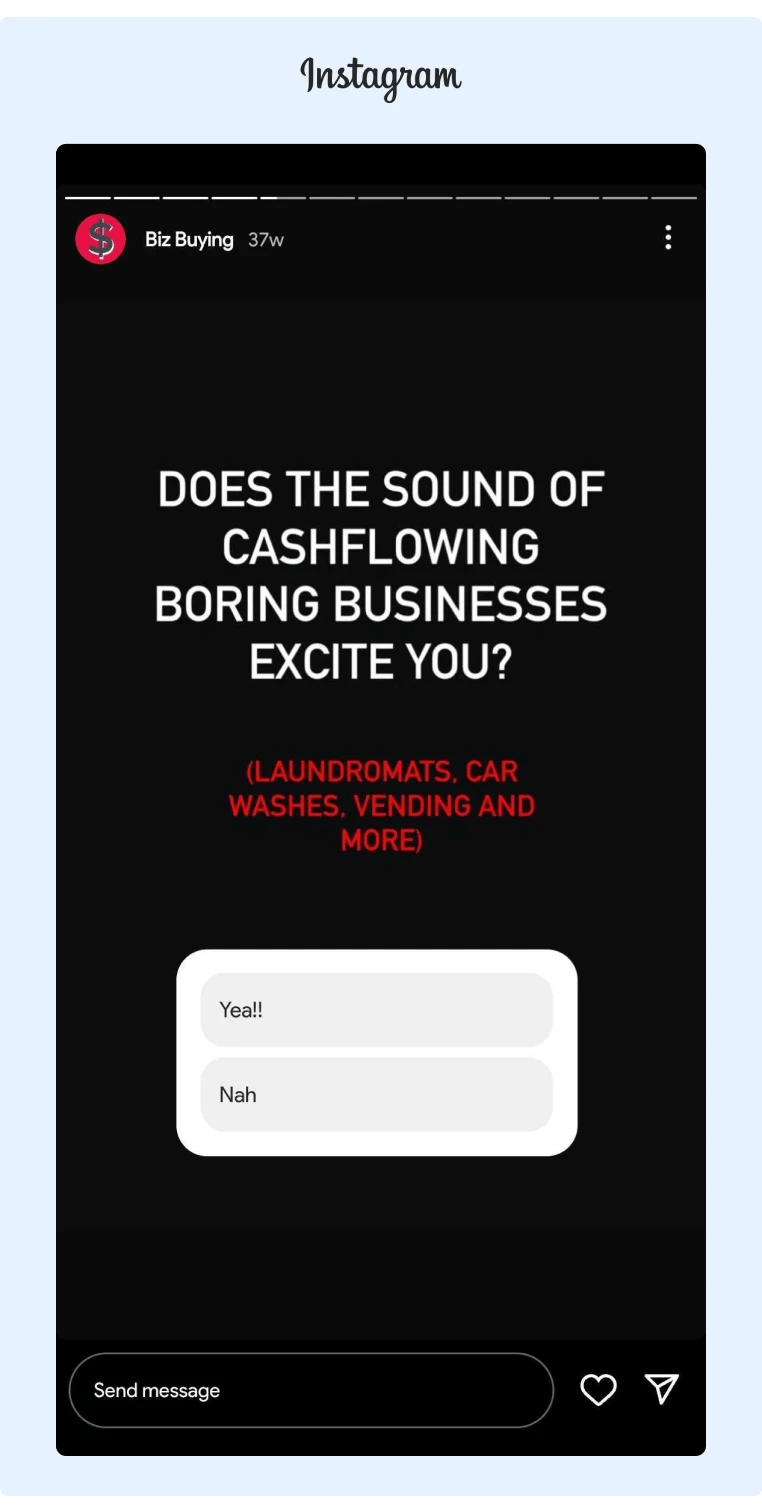
Instagram Story Optimization Tips:
-
Leverage engagement features like polls, quizzes, and surveys.
-
Tag relevant people with the @mention.
-
Use the “Add Yours” sticker to post a prompt and add a corresponding photo based on the prompt.
-
Add a relevant call to action with a link.
-
Use the countdown timer if you’re promoting a sale.
-
Incorporate relevant hashtags.
-
Turn on sharing capabilities.
Instagram Carousels
Instagram carousels are posts that string together multiple photos or videos. Unlike Stories, Instagram carousels don't disappear and live on your business page indefinitely.
You can also run ads to Instagram carousels.
Here's a great example of a Tweet that was repurposed as an Instagram carousel with great success:
Instagram Carousel Optimization Tips:
-
Use the following sizing ratios: square (1:1), horizontal (1.91:1), and vertical (4:5).
-
Use the following resolutions: 1080 x 1080 pixels for images, and between 600 x 600 pixels and 1080 x 1080 pixels for videos.
-
Add a relevant CTA to get users to take action after consuming your content.
-
Leverage storytelling techniques to get people to continue clicking through your carousel.
-
Repost your carousels on other platforms like LinkedIn.
Step 2. Run Ads
Instagram ads are excellent for generating more brand awareness and selling products. And you can use various content styles, including photos, videos, carousels, stories, and reels to create ads.
These ads are particularly effective for e-commerce brands since you can add a call-to-action button to your product thanks to the Instagram app's new Checkout feature. Then, customers can purchase your products directly inside the mobile app:
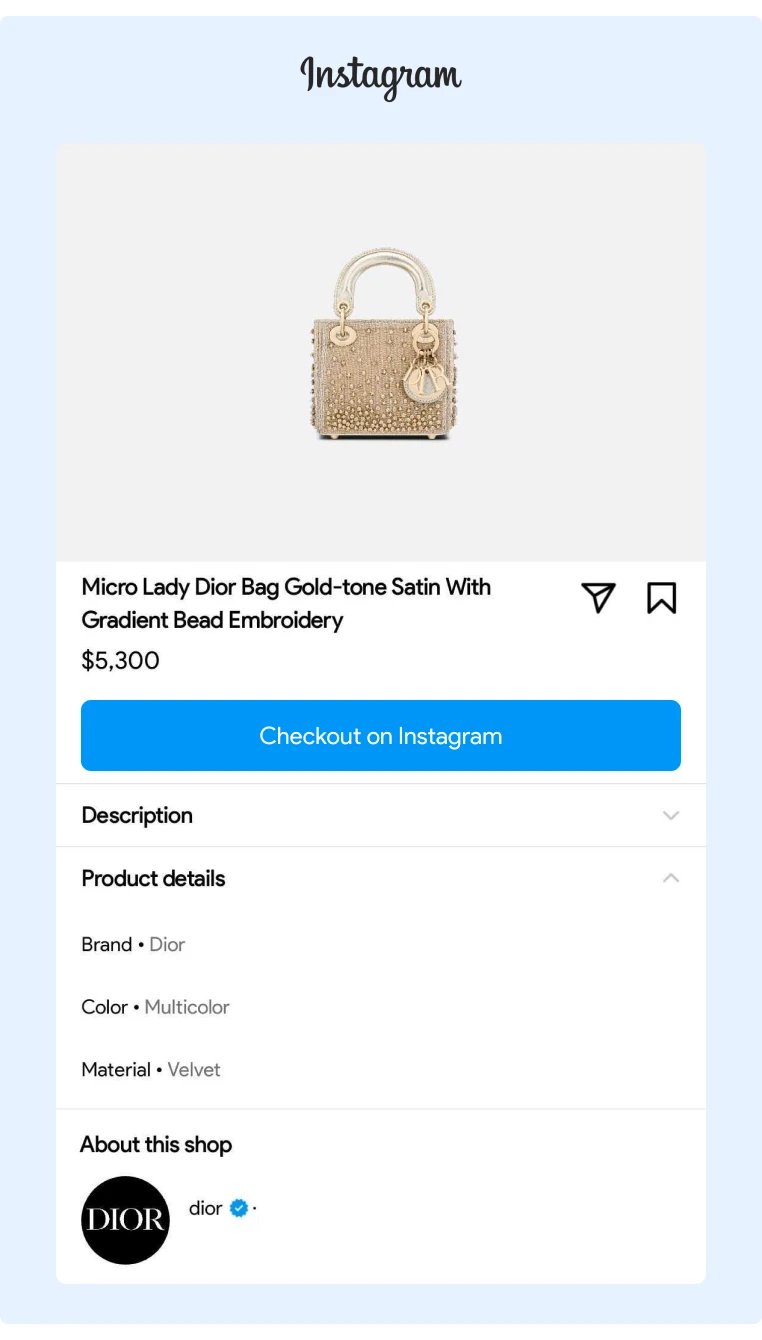
If you're already running Facebook ads, you'll be able to quickly pick up Instagram business ads because it uses the same Ads Manager.
If you're not running Facebook ads, the first step to running Instagram ads is setting up the Facebook ad pixel.
Once you've done that, select one of the campaign objectives Instagram offers:
-
Conversions.
-
Lead generation.
-
App installs.
-
Video views.
-
Engagement.
-
Traffic.
-
Reach.
-
Brand awareness.
By selecting one of these objectives, Instagram uses Meta's data and optimizes your ad for the selected objective.
You can then select your budget, target audience, and placements to show your ads on. From there, you'll have the option to design your ad directly inside Ads Manager.
If you want more help, here's a detailed breakdown of setting up Instagram ads.
Once you've set up your ads, here are a few tips to improve your ROI:
-
Test different hooks for videos and stories, and leverage storytelling techniques.
-
Test various content formats (stories, reels, videos, etc.) and styles (funny, serious, personal, etc.).
-
Take your most effective organic posts and incorporate them into your ad strategy.
-
Leverage Meta's advanced audience targeting features.
Step 3: Partner With Influencers (And Do Guest Carousels)
Instagram is the most popular platform for influencer marketing, meaning it will be easier for you to find influencers and run campaigns on Instagram than other social media platforms.
To get started, consider signing up for an influencer marketing platform like Upfluence or Intellifluence. These platforms allow you to find, message, hire, manage, and pay influencers in one place.
Alternatively, you can run these campaigns manually if you don't want to use a platform. To find relevant influencers, search for parallel brands to see their influencer partners. For example, if you sell hair products, look at influencers promoting makeup products.
Here's an example of an influencer promoting products for Rare Beauty who might be a great fit:
We recommend avoiding influencers who have partnered with a direct competitor as they typically have non-compete agreements.
Another great way to find relevant influencers is to look at your existing customer base. If any of them have a substantial following, reach out and offer to do a partnership.
Once you've found a handful of promising influencers, how do you evaluate them and choose one?
While follower count is a good indicator of audience size, micro-influencers often tend to have more loyal followers and generate higher engagement and conversion rates. Here are a few other key metrics to consider:
-
Post engagement rate.
-
Audience relevancy.
-
Brand value alignment.
-
Content style and quality.
-
Past performance for parallel brands.
Influencer marketing platforms generally share this information with you. If you decide to conduct influencer marketing campaigns manually, you'll have to get this information from the influencer.
Step 4: Cross-Promote With Similar Brands
While influencer marketing is a great way to scale reach quickly, you can also do mutual collaborations with parallel brands.
The best part about this strategy is that you generally don't have to pay for these partnerships. However, you will need a comparable audience size to make it mutually beneficial.
Chris Do is an excellent example of a B2B influencer who quickly scaled his Instagram following through partnerships.
He started by simply writing guest carousels for other creators. For example, he collaborated with marketing expert Eric Siu, and both wrote guest carousels for each other’s Instagram accounts.
He also created collaborative videos, like this one with branding coach Jefferson Isesele:
While this shows how individual influencers can do cross-promotions, brands can use the same strategy.
For example, if you do a podcast or webinar with a parallel brand, ask them to cross-promote it on their Instagram.
Step 5: Encourage Employee Advocacy
Instagram's algorithm is designed to give more reach to posts with high engagement. One of the best ways to help your posts generate more reach is to ask your employees to like, comment, and share branded posts when they go live.
The tricky part is getting your employees to respond and engage with the content.
While most employees oblige to your first few requests, you'll notice that engagement drops over time.
So, to improve employee engagement, we built GaggleAMP. It allows you to assign specific engagement activities to employees at scale.
For example, you can select one of the Instagram engagement activities, fill it out with specific instructions, and add a due date. Then, you can assign it to an employee or group of employees.
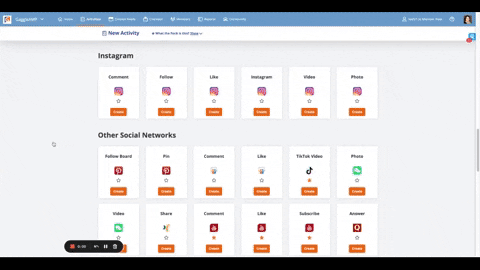
Once you assign the engagement activity, employees receive a notification via Slack or email and can log into their personalized Gaggle to view their engagement activities.
A key benefit of GaggleAMP is that employees can complete most engagement activities directly inside the Gaggle and schedule the publish date.
This means employees never have to log into their personal accounts to complete the engagement activity, and they can finish all tasks in one sitting.
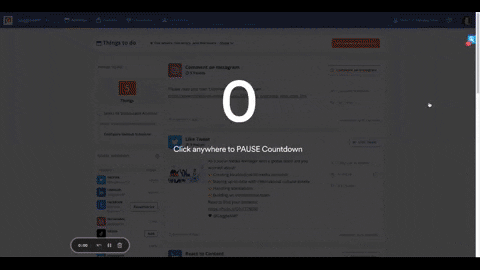
Minimizing the effort required of your employees makes them much more likely to oblige to your requests.
Step 6: Track Results
The tips above are a good basic framework to help you get started with Instagram for business, but there isn't one perfect strategy for all businesses.
Instead, you'll have to test different aspects and find what works for your audience.
So, as you run your Instagram campaigns, consider testing:
-
Content formats.
-
Promotion strategies.
-
Ad audiences.
-
Partners (brands and influencers).
If you need some inspiration, look at what your competitors are doing and try incorporating aspects of their social media strategy. Over time, you'll find your unique strategy, but don't try to reinvent the wheel from scratch.
To track your results, you can use Instagram's Insights dashboard, which gives you detailed analytics like:
-
Accounts reached.
-
Accounts engaged.
-
Total followers.
-
Impressions.
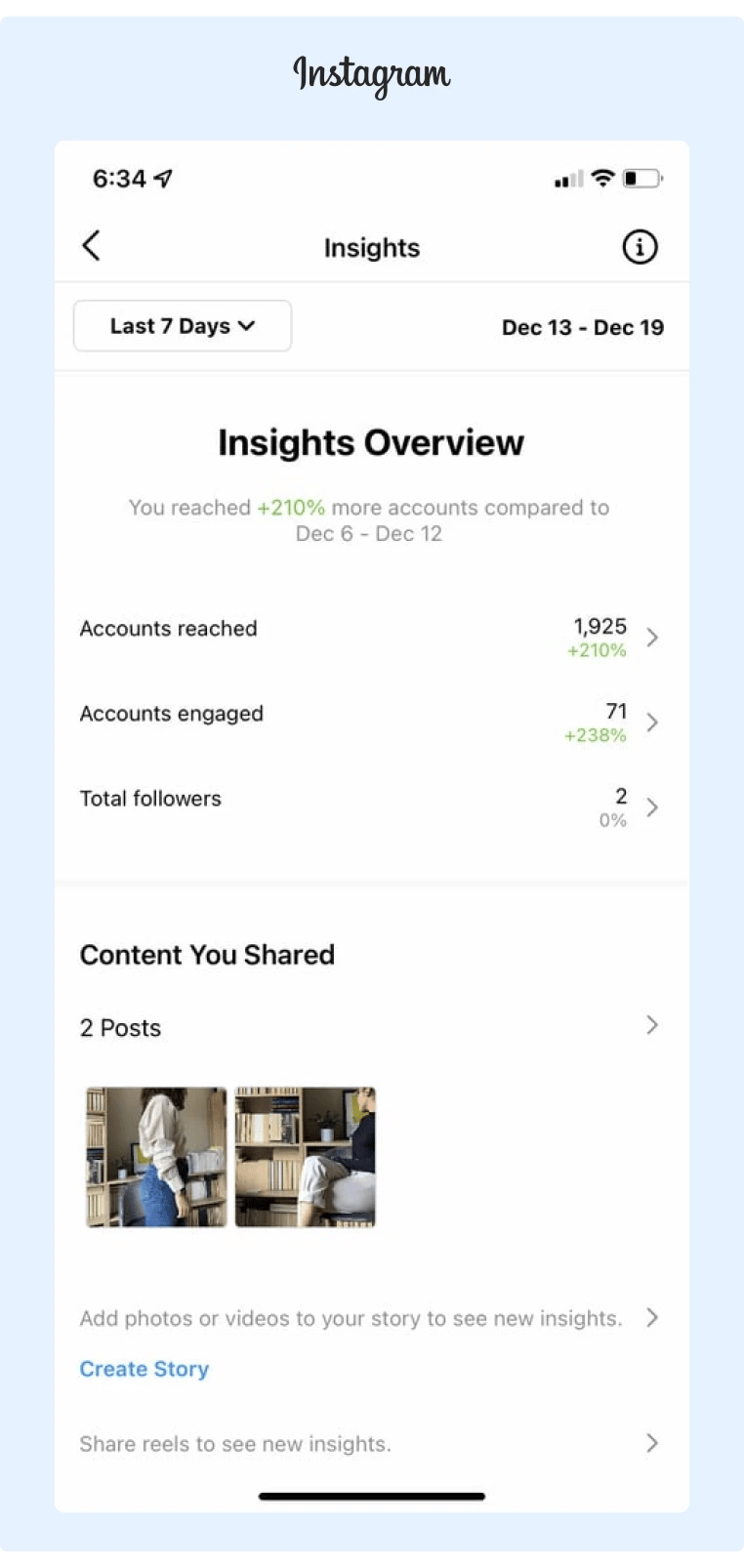
You can also see a full breakdown of stats for each individual post, which can help you figure out what kind of content resonates best with your audience.
One final note is that it's important to gauge the quality of your audience.
For example, giveaway contests tend to generate a lot of engagement, but they don't always attract the right audience.
So, track comment relevancy, total conversions, and who DMs your business to gauge the general quality of the engagement you're generating.
Incorporate Instagram Into Your Digital Marketing Strategy Today
There are plenty of different social networks you can use to promote your business, though Instagram is an excellent option if you’re an e-commerce company or already creating visual content.
Just follow the step-by-step instructions above, and whether you’re growing a Fortune 500 company’s brand or a small business owner earning your first few customers, you’ll be well on your way to growing a valuable Instagram audience.
If you want to supercharge your Instagram growth by leveraging employee advocacy, schedule a demo of GaggleAMP today.









